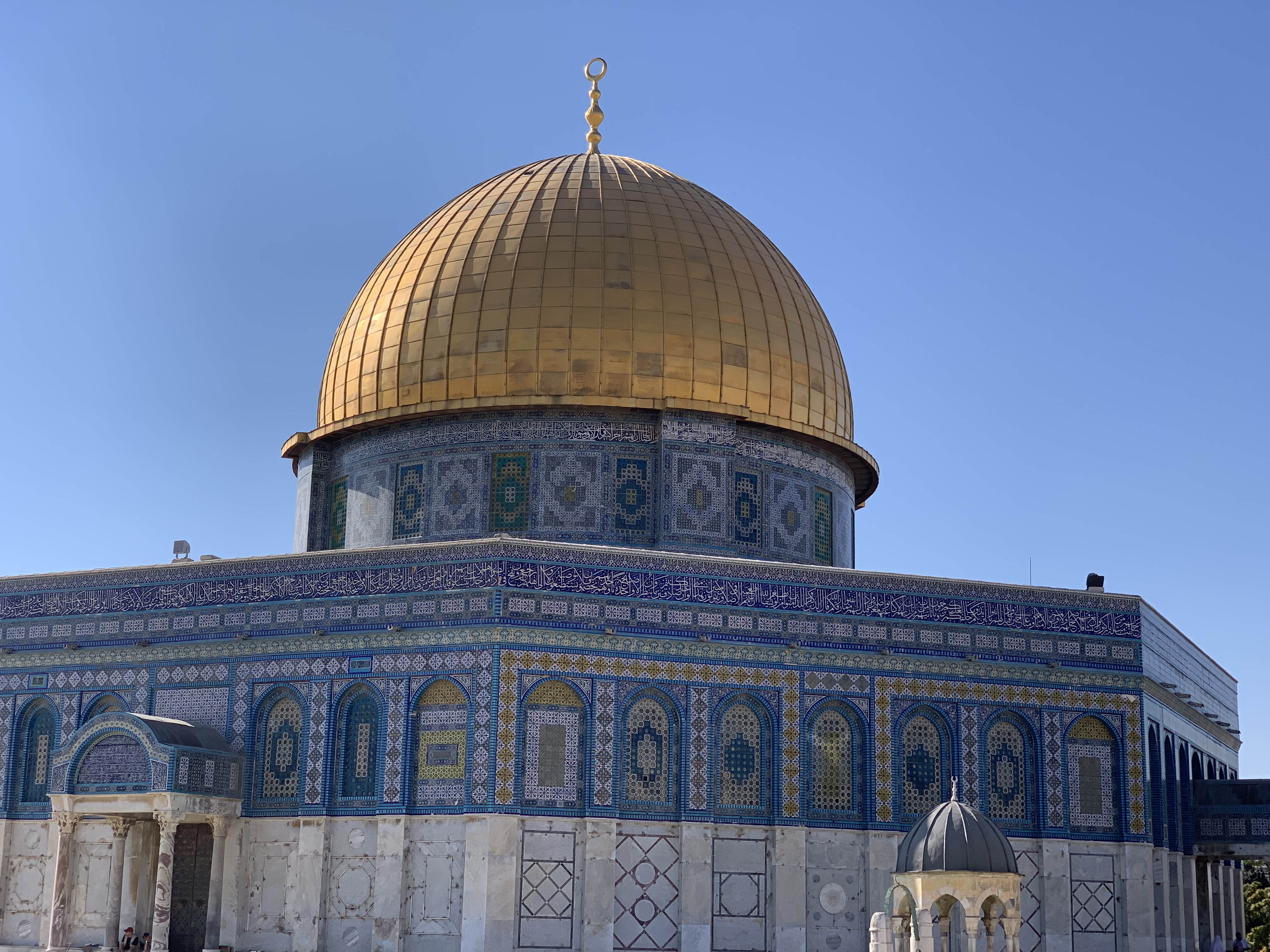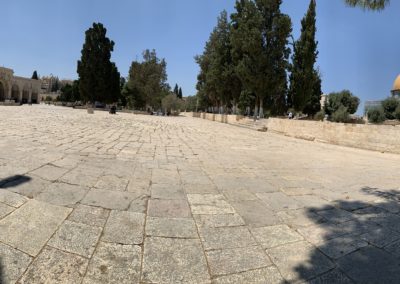Holy Land for Muslims
In the Quran, the term Al-Ard Al-Muqaddasah (Arabic: الأرض المقدسة, English: “Holy Land”) is used in a passage about Musa (Moses) proclaiming to the Children of Israel: “O my people! Enter the holy land which Allah hath assigned unto you, and turn not back ignominiously, for then will ye be overthrown, to your own ruin.”[Quran 5:21] The Quran also refers to the land as being ‘Blessed’.[24][25][26]
Jerusalem (referred to as Al-Quds, Arabic: الـقُـدس, “The Holy”) has particular significance in Islam. The Quran refers to Muhammad’s experiencing the Isra and Mi’raj as “a Journey by night from Al-Masjidil-Haram to Al-Masjidil-Aqsa, whose precincts We did bless …”.[Quran 17:1][24] Ahadith infer that the “Farthest Masjid” is in Al-Quds; for example, as narrated by Abu Hurairah: “On the night journey of the Apostle of Allah, two cups, one containing wine and the other containing milk, were presented to him at Al-Quds (Jerusalem). He looked at them and took the cup of milk. Angel Gabriel said, ‘Praise be to Allah, who guided you to Al-Fitrah (the right path); if you had taken (the cup of) wine, your Ummah would have gone astray’.” Jerusalem was Islam’s first Qiblah (direction of prayer) in Muhammad’s lifetime, however, this was later changed to the Kaaba in the Hijazi city of Mecca, following a revelation to Muhammad by the Archangel Jibril.[27] The current construction of the Al-Aqsa mosque, which lies on the Temple Mount in Jerusalem, is dated to the early Umayyad period of rule in Palestine. Architectural historian K. A. C. Creswell, referring to a testimony by Arculf, a Gallic monk, during his pilgrimage to Palestine in 679–82, notes the possibility that the second caliph of the Rashidun Caliphate, Umar ibn al-Khattab, erected a primitive quadrangular building for a capacity of 3,000 worshipers somewhere on the Haram ash-Sharif. However, Arculf visited Palestine during the reign of Mu’awiyah I, and it is possible that Mu’awiyah ordered the construction, not Umar. This latter claim is explicitly supported by the early Muslim scholar al-Muthahhar bin Tahir.[28] According to the Quran and Islamic traditions, Al-Aqsa Mosque is the place from which Muhammad went on a night journey (al-isra) during which he rode on Buraq, who took him from Mecca to al-Aqsa.[29] Muhammad tethered Buraq to the Western Wall and prayed at al-Aqsa Mosque and after he finished his prayers, the angel Jibril (Gabriel) traveled with him to heaven, where he met several other prophets and led them in prayer.[30] The historical significance of the al-Aqsa Mosque in Islam is further emphasized by the fact that Muslims turned towards al-Aqsa when they prayed for a period of 16 or 17 months after migration to Medina in 624; it thus became the qibla (“direction”) that Muslims faced for prayer.[31]
The exact region referred to as being ‘blessed’ in the Quran, in verses like 17:1, 21:71 and 34:18,[24][25][26] has been interpreted differently by various scholars. Abdullah Yusuf Ali likens it to a wide land-range including Syria and Lebanon, especially the cities of Tyre and Sidon; Az-Zujaj describes it as, “Damascus, Palestine, and a bit of Jordan”; Muadh ibn Jabal as, “the area between al-Arish and the Euphrates”; and Ibn Abbas as, “the land of Jericho”.[32] This overall region is referred to as “Ash-Shām” (Arabic: الـشَّـام)
From <https://en.wikipedia.org/wiki/Holy_Land>
Grand Mosque in Mecca
It was called the Haram because God prohibited fighting in it, and it is the greatest mosque on the face of the earth and the first mosque as well. In it the Prophet Muhammad, may God bless him and grant him peace, was sent, and in it the honorable Kaaba, which is the qiblah of Muslims and the center of the earth, and in it the well of Zamzam, the best water on earth, and the shrine of Abraham. As for the dome, the Kaaba is instead of the main dome. For the mosque, but there are three sub-domes located in Mecca, the Arabian Peninsula, Saudi Arabia. Prayer in it is equivalent to one hundred thousand prayers and Muslims go to it to perform Hajj in the month of Dhul-Hijjah and Umrah. So they perform it and pray in the mosque and drink from Zamzam water, then kiss the Black Stone, the best of the earth’s stones, and from it my family goes to Al-Aqsa Mosque.
Prophet’s Mosque
It was called al-Nabawi because it was a mosque for the Messenger Muhammad, may God bless him and grant him peace, and it is the second greatest mosque. Muslims come to him to visit the tomb of the Prophet, may God bless him and grant him peace, and greet him. The main dome of the mosque is the green dome, with a gray dome next to it
Al-Aqsa Mosque
It is called Al-Aqsa because it is the furthest from the Two Holy Mosques (the Great Mosque and the Medina) and it is the third greatest mosque and the second mosque on earth, so 40 years between it and the Grand Mosque (the first mosque) and it is the first of the two qiblahs. It is located in Jerusalem – Palestine occupied by the Jews after their occupation of Palestine. The main dome is the Dome of the Rock.





